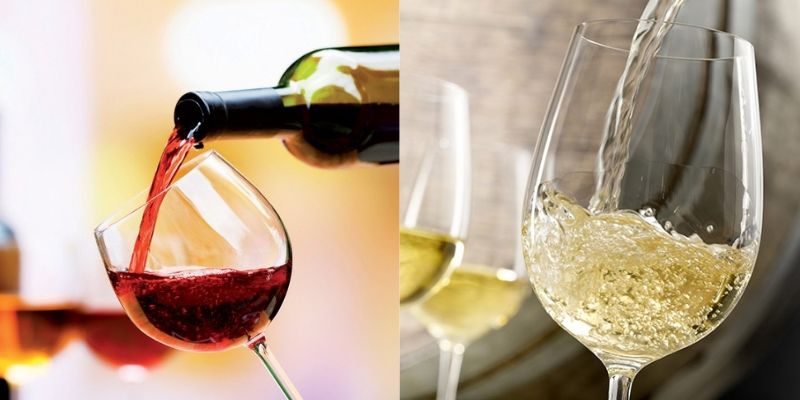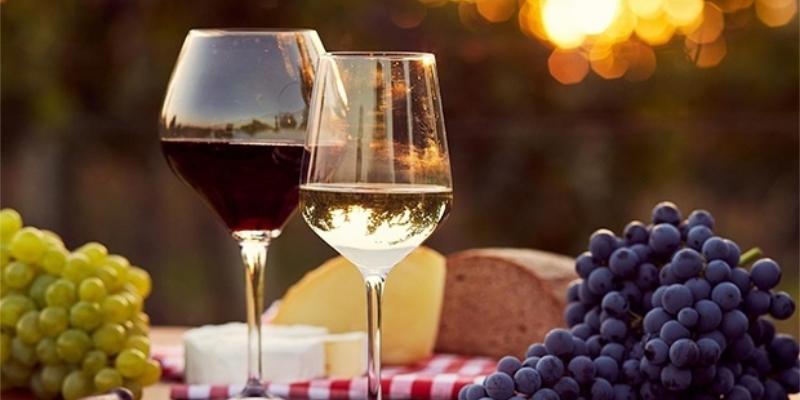Wine
Wine is crafted from grapes and aged in oak or stainless steel barrels.
During fermentation, the sugar in grape juice transforms into a mildly sweet, low-alcohol beverage, making it a popular choice among women.

Red Wine vs. White Wine: A Comparison
|
Red Wine |
White Wine |
|
|
Ingredients |
Made from red or black grapes. Uses fully ripe grapes, including skins and seeds. |
Uses red and white grapes. Only the flesh of ripe grapes is used, discarding the skins and seeds. |
|
Process |
Grapes are pressed after fermentation. Longer aging process. |
Grapes are pressed before fermentation. Shorter aging period. |
|
Color |
Red |
White, yellow, or straw-colored |
|
Flavor Profile |
Fruity notes of cherry, raisin, strawberry, raspberry, blackberry, cranberry, gooseberry, and blackcurrant. Distinctive flavors: nut (white and black), coca, toast, smoke, licorice, cinnamon, garlic, and onion. |
Fruity flavors: citrus, apple, pear, grape, lemon, pineapple, and watermelon. Distinctive notes of honey, flowers, grass, and herbs. Unique flavors depending on the region of production. |
|
Nutritional Value |
One glass of red wine contains: 125 Calories 4g Carb 1g Sugar Higher levels of vitamins and minerals. Rich in plant compounds like Tannin and Resveratrol. |
The same volume of white wine provides: 121 Calories 4g Carb 1g Sugar Lower levels of vitamins and minerals. Fewer beneficial plant compounds. |
|
Benefits |
Reduces the risk of heart disease. Increases HDL Cholesterol levels. Slows down brain function decline. Prevents cartilage damage. Prevents complications from diabetes. Activates cells and slows down aging. Aids in cancer treatment. |
Aids in weight control and weight loss. Fights against various heart conditions, including arrhythmia, heart attacks, and strokes. Inhibits the growth of cancer cells. Promotes relaxation and soothes the mind. Prevents diabetes, especially type 2. Reduces the risk of osteoporosis. |

Important Consumption Notes
Limit your intake to 1-2 glasses of wine per day.
The ideal time to enjoy wine is between 11 am and 1 pm, as your sense of smell is at its peak during this period, allowing you to fully appreciate the wine’s aroma.
On weekdays, you can indulge in a glass of wine between 7 pm and 9 pm to stimulate your taste buds and unwind after a long day.
Chill your wine before serving, and avoid using ice as it dilutes the flavor and reduces the nutritional value.
The proper way to hold a wine glass is to rest your index finger on the bowl, while your thumb and middle finger support the stem, with the remaining fingers relaxed.

While both red and white wines offer similar nutritional benefits, they have distinct flavors and advantages. However, excessive consumption can lead to adverse health effects. Don’t forget to check out interesting facts about wine!
Unveiling the Calorie Counts in Your Favorite Tipples
Introducing the world of alcoholic beverages – from cocktails to craft beers and fine wines. These beloved tipples are a staple at social gatherings, but did you know that a night of indulging can add up to a whopping 1000 calories? That’s right, those innocent-looking drinks can pack a punch when it comes to your waistline. So, whether you’re a cocktail connoisseur or a beer enthusiast, it’s important to keep a mindful eye on your consumption. Cheers to a healthy balance!
The Don’ts of Beef Preparation
Beef is a powerhouse of protein and nutrients, making it a favorite among health-conscious homemakers and fitness enthusiasts alike. But there’s more to this versatile meat than meets the eye. When preparing beef, there are some critical dos and don’ts that every cook should know. We’ll reveal the secrets to unlocking the full potential of this delicious and nutritious staple, so you can create mouth-watering dishes that not only taste amazing but also fuel your body with the goodness it deserves.



































